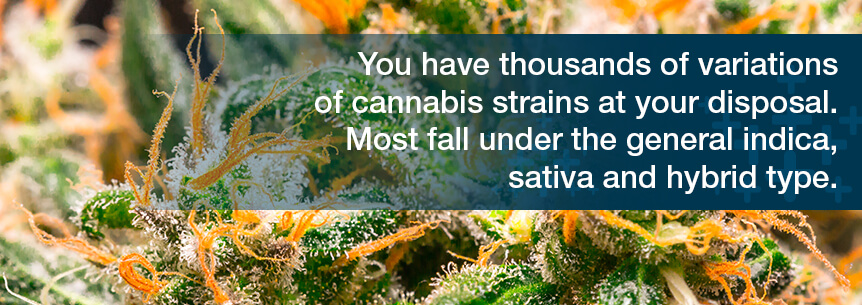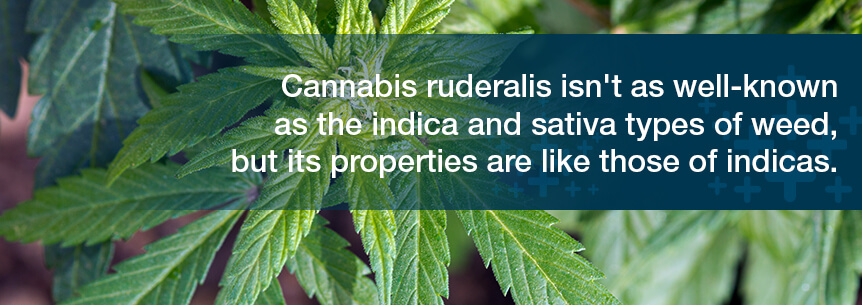You have the option to select many different medical cannabis types, strains and flavors. Choosing between them could get a little overwhelming if you’re looking to relieve symptoms of one or more of your medical conditions.
If you’re just getting started with cannabis treatment, the mere thought of walking into a dispensary for the first time may leave you anxious. With all the options available to you and their different healing properties, it’s no wonder newcomers often think twice about marijuana therapy. MarijanaDoctors.com is here to help you gain an understanding of the different types of medical cannabis available to you.
In this part of the guide, you’ll discover the most common types of cannabis, and what you will likely experience from each of them. You’ll also learn about the different strains breeders make from the various “types” of cannabis.
You should know the effects you’re looking for since each type and strain of cannabis has its distinction to help your symptoms in various ways. Some will help you relax and ease your stress, while others will give you energy and uplift your spirits.

You have thousands of variations of cannabis strains at your disposal. Most fall under the general indica, sativa and hybrid type.
Indica strains are more suitable for relieving stress and promoting relaxation since they provide a sedating effect. They’re a strong type of cannabis that comes in several flavors and contains higher amounts of resin. They are typically grown in harsh climates and commonly in countries like Lebanon, Nepal, Afghanistan and Morocco.
Because of the stronger sedative properties of indica blends, doctors typically prescribe them to provide the following symptom relief:
Other uses of indica blends exist, but the above are the most common.
Pure indicas are dense, dark green short plants with broad leaves and chlorophyll. They also have less accessory pigments, which are supposed to prevent excessive sunlight from damaging the plant.
Indicas usually mature within six to eight weeks once flowering starts. Since they don’t grow as tall as sativa plants, they cultivate better indoors. The flowers offer various aromas and flavors ranging from fruity and sweet to pungent skunk.
Sativa strains offer uplifting, invigorating and cerebral effects suited more for physical activity. Sativas supposedly enhance creativity and come in a variety of flavors from fruity and sweet to earthy. They grow in places like Thailand, India, Colombia and Mexico.
Sativa cannabis strains help to:
Pure sativa marijuana strains are more difficult to cultivate, especially outdoors and indoors in Canada and other parts of the northern hemisphere. Therefore, they’re rare in the medical field. And, since vendors prefer stocking favorite strains, the seeds of pure sativas are also uncommon since they’re not popular.
They’re also rare in the medical field because consuming too much pure sativa can induce irregular heartbeats and paranoia. They grow into thin, tall plants with light green narrow leaves, reaching up to 20 feet tall in just one season. After they begin flowering, pure sativas can take between 10 to 16 weeks before they are completely mature.
Hybrids provide both indica and sativa strains. Hybrid cannabis strains usually indicate the combination of seeds from various geographic locations worldwide where marijuana grows. Since they’re a mixture of cannabis plants with various characteristics, they offer you the best of both worlds.
Typically, breeders work hard to create multiple weed hybrids to cater to the needs of users. One of the main goals of creating hybrids is to mix each marijuana strain’s positive properties and characteristics. In today’s market, most medical cannabis is hybrid.
Cannabis strains carry a wide range of health benefits. There are some that help with:
1. Moods and Activities
Some strains help with your energy level and mood. For instance, some strains help:
2. Medical Ailments
There are other strains individuals use more for their medical benefits, such as to help you:

Patients suffering from depression or fatigue might turn to a sativa in the daytime, while another patient who’s dealing with insomnia and pain will probably go with an indica at night. Realize a “heavy” or strong high, usually from potent indicas, are known as a “body stone”, and this means you shouldn’t plan on participating in a lot of physical activity after using it.
Sativas tend to produce energy so you might choose this type if you’re looking for a productive day while you treat your symptoms. Hybrids tend to mix both these characteristics.
Budtenders at marijuana dispensaries can inform you of the type of strain your purchasing. Strain information is also located on the product jar label since proper marijuana packaging and labeling is essential for cannabis companies to stay in compliance with state guidelines.
Each strain comes from a type of marijuana like sativa, indica, hybrid, etc., and each has its unique name and healing properties as well. Examples include:
Another fundamental factor between sativas and indicas that dictates the differences and similarities of the two are cannabinoids — specifically CBD and THC. If you’re an experienced cannabis user or have been researching the herb, you’ve likely heard of cannabinoids.
We’ll get into cannabinoids in more detail in chapter four, but for now, know the two primary cannabinoids in the medical pot plant are CBD (cannabidiol) and THC (tetrahydrocannabinol):
When you’re looking for a strain to treat your health condition, but you don’t want the psychoactive effects, you’ll want to look for a strain high in CBD and low in THC.
CBD, up until recently, hasn’t been as commonplace as THC. However, because CBD is non-psychoactive, scientists and researchers study it frequently in scientific studies.
Medical cannabis types and strains can fluctuate widely in its percentage of CBD or THC and aren’t always 100 percent reliable. You can, for instance, have sativas that have higher levels of CBD content than indicas or indicas that have higher THC than sativas. Therefore, it may be more helpful if you focus on the general species effects instead of looking at their chemical properties exclusively.
While indica and sativa are the main types of marijuana, for the sake of discussion, we should include a couple more you’ll find, which include ruderalis and industrial hemp.

Cannabis ruderalis isn’t as well-known as the indica and sativa types of weed, but its properties are like those of indicas. Ruderalis is often grown in the world’s northern countries. Because it doesn’t produce as much psychological effect on users as the other two types, researchers don’t study it as much.
Like cannabis sativa and cannabis indica, cannabis ruderalis is also a subspecies of marijuana. It’s derived from Central Russia and offers some extraordinary distinguishable and unique qualities due to environmental pressures and inbreeding. It has minimal amounts of THC in it, so it’s rarely grown for recreational purposes.
It is, however, becoming a popular plant breeding stock for medical strains since its high in CBD. The flowers of ruderalis are based on age instead of light cycle — referred to as “autoflowering.” So, if you grew it under 24 hours of light indoors, it would begin producing flowers automatically on its genetic schedule. Therefore, if breeders crossbreed it with a sativa or an indica, the plant would probably autoflower and contain higher CBD levels.
Additionally, ruderalis is very resistant to disease and insect damage. The medical benefits of ruderalis have dramatically changed how seed breeders and geneticists create strains these days.
Industrial hemp also comes from the cannabis sativa plant, but it’s grown for industrial purposes specifically. Its overall use is for textile, fiber and animal feed. It’s not a good medical cannabis product due to its low THC content.
It may take you some time to figure out your personal preference for the type of medical marijuana you prefer. Don’t hesitate to ask a budtender or your marijuana doctor questions. You may even find yourself experimenting to discover the type and strain that suits you best.